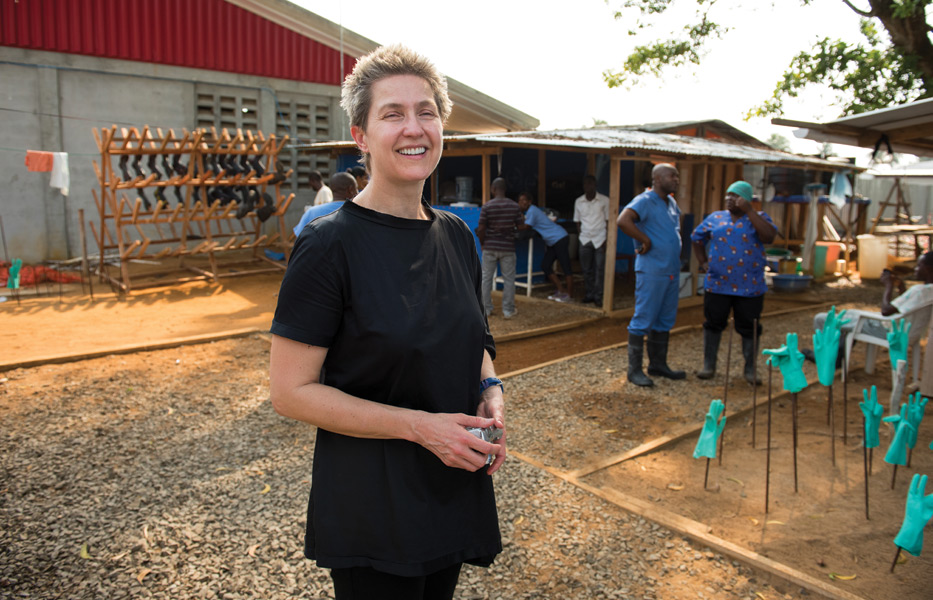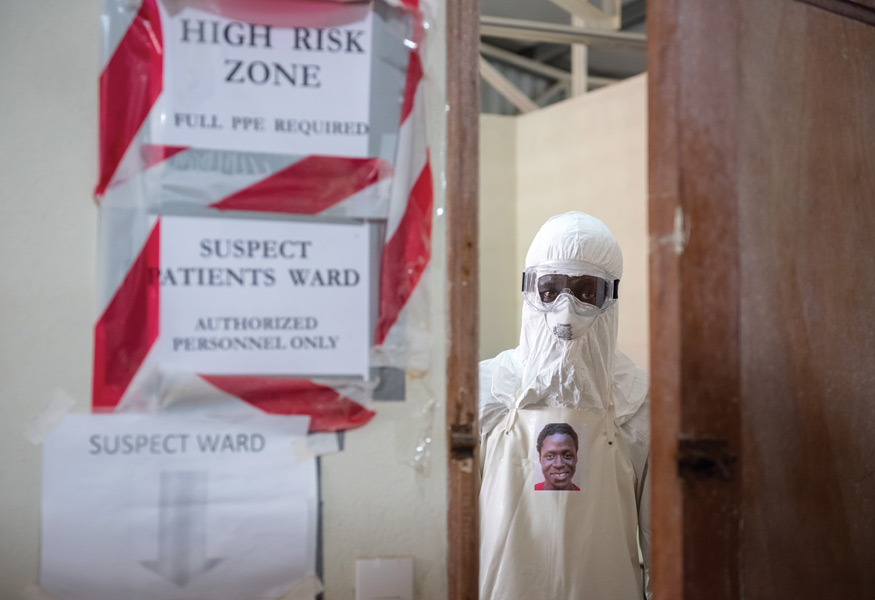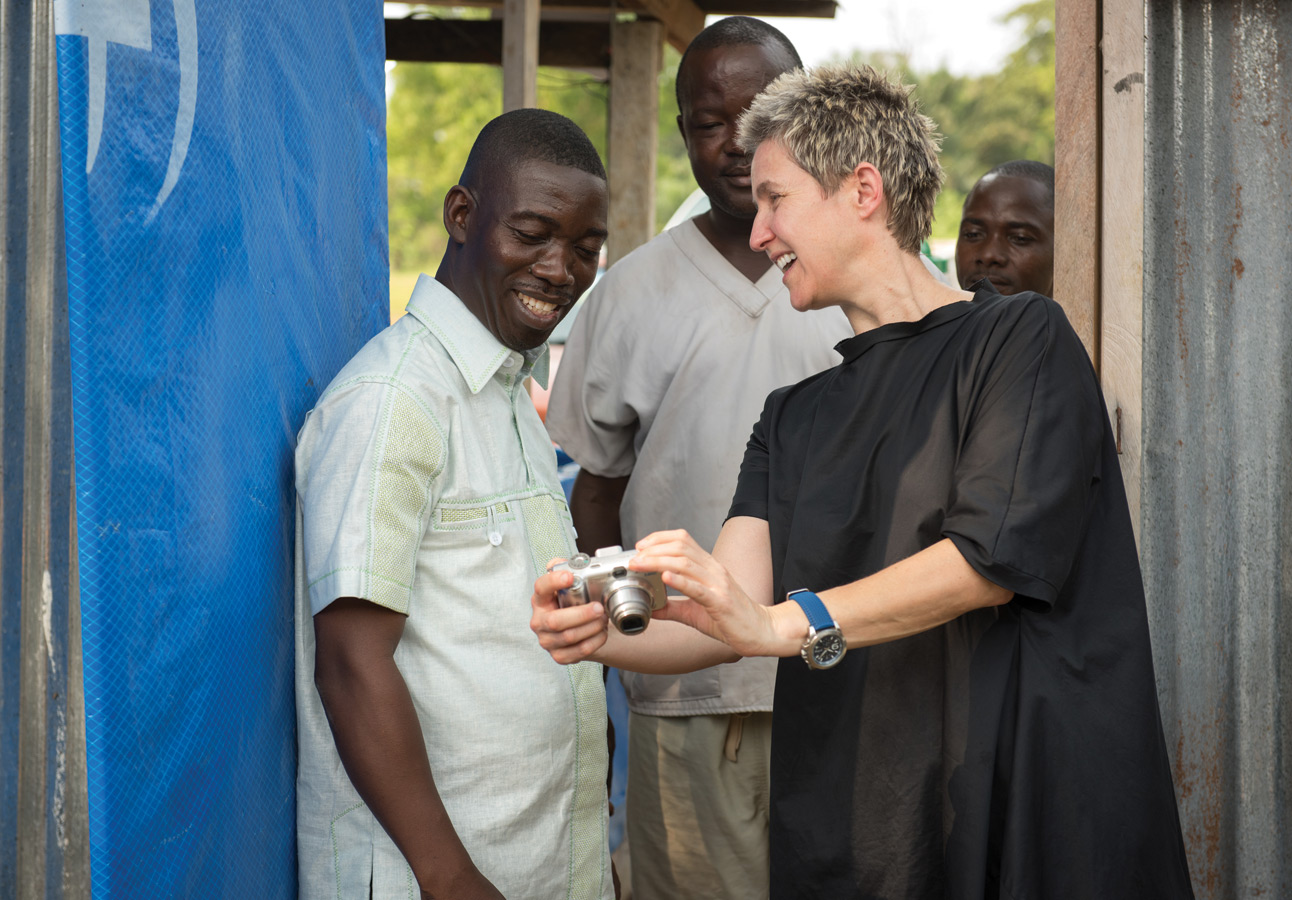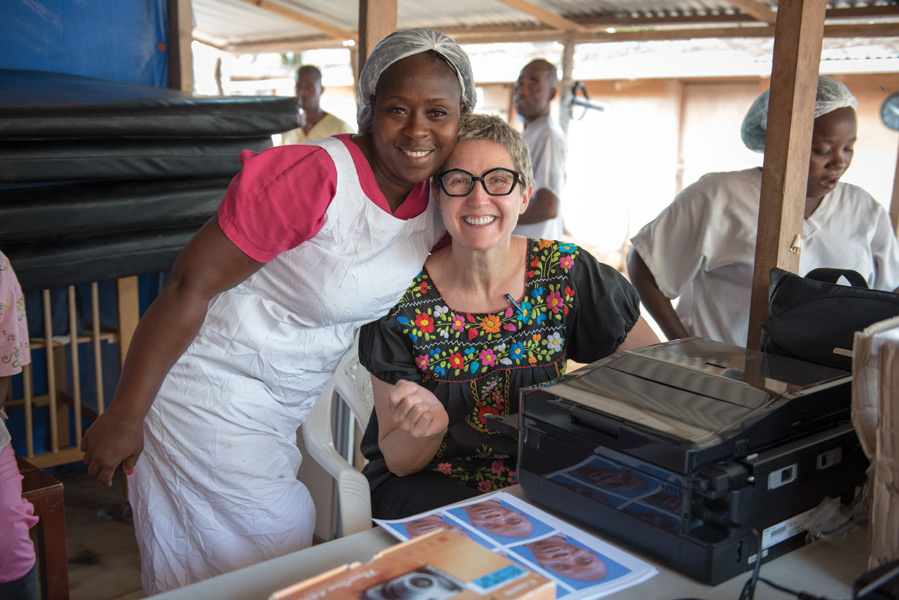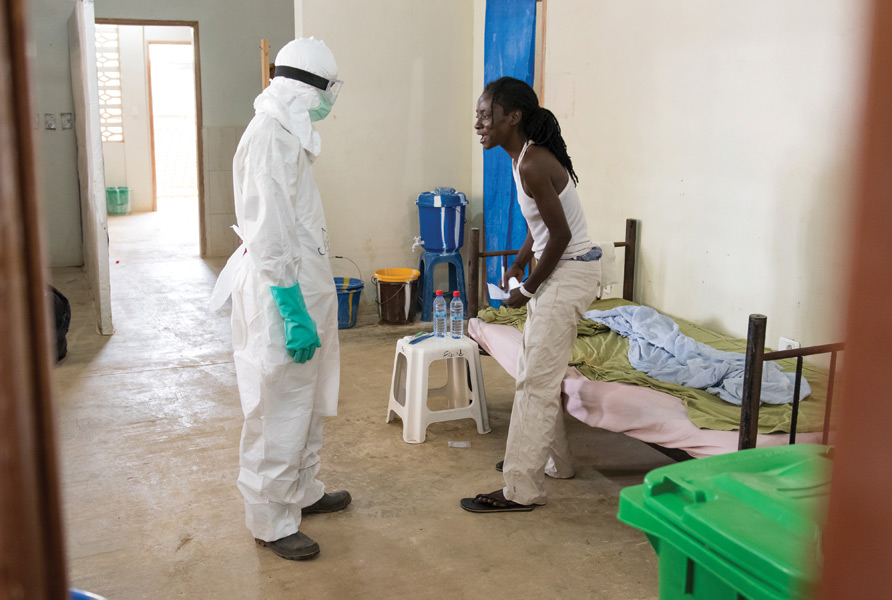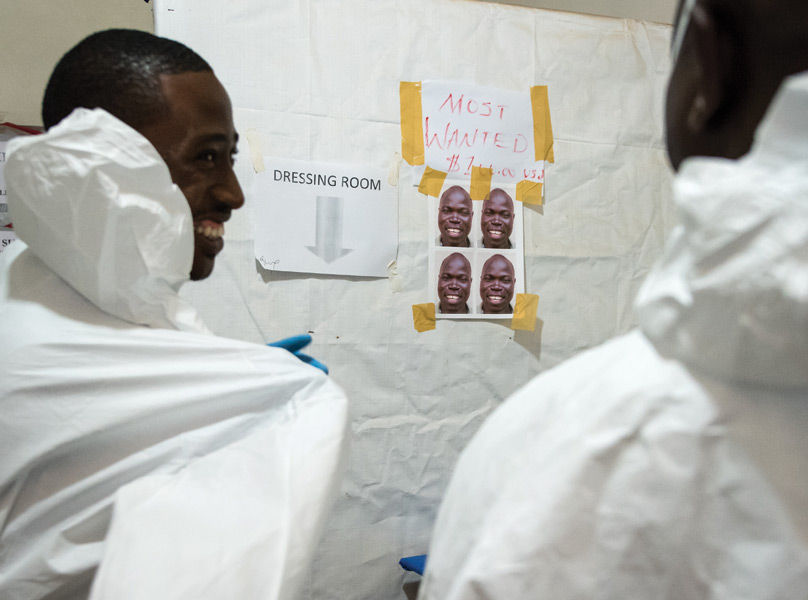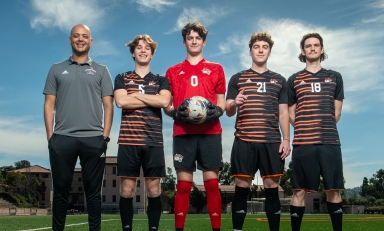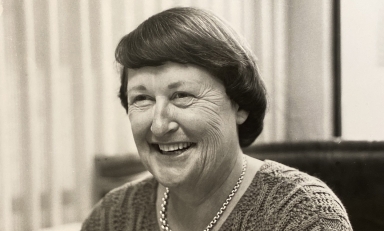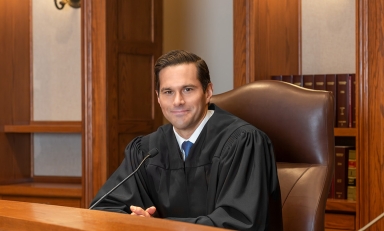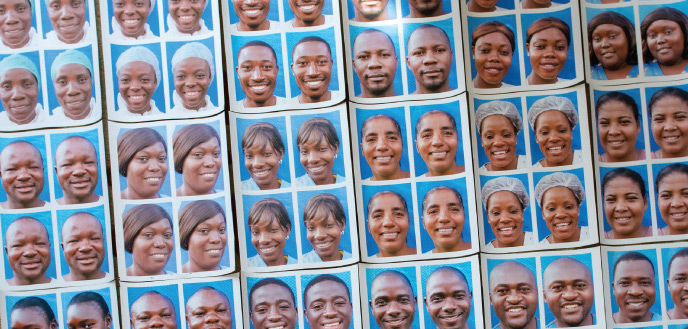
Associate professor Mary Beth Heffernan saw a problem with Ebola care in Africa—personal protection equipment suits that made the medical workers wearing them appear frightening and impersonal. So she came up with a simple solution: adhesive and disposable portraits for their uniforms. Photographer Marc Campos accompanied Heffernan on a three-week journey to Liberia that transcended its mission of social practice art
Story and Photos by Marc Campos
For readers of Time, Dr. Jerry Brown became the face of a mission when the newsmagazine named the Ebola Fighters of West Africa as its 2014 Person of the Year. In his white personal protective equipment, framed by a pair of purple-edged goggles, Brown may be the least recognizable cover subject in the award's 87-year history. He jokes with staff about how his eyes are famous. He has a slightly weary demeanor, no doubt brought on by a full year in crisis mode.
Physician assistant Reginald M. Poindo of Liberia describes what he felt while working in an Ebola treatment unit (ETU) last October, at the peak of the virus' outbreak in Monrovia. "It was like going to hell and back," he says. "People were very afraid. My own wife forbid me to come and participate. I had to persuade her."At the same time, Mary Beth Heffernan, associate professor of art history and visual arts at Occidental, was trying to get into Liberia, into an ETU. She had an idea.
Heffernan had seen images in the news of healthcare workers tending to the sick and carrying away the dead, all in the white or yellow PPE "spacesuits" that covered them from head to toe. However necessary such precautions were, workers clad in PPE came to represent the fear of danger and death from a disease with no cure, even earning the nickname "scary ninjas" by those who have seen them taking away loved ones.
Heffernan recognized the fear patients could have when faced with only PPE-clad healthcare workers. "Why don't they just put ID photos on the outside of the PPE?" she thought. Her idea was a simple one: Stick a photo of the healthcare worker onto their PPE to give Ebola patients a face to see during their quarantine. Such a small gesture, she reasoned, would restore a little humanity to the situation and help with the workers' bedside manner. Armed with a grant from the Arnold P. Gold Foundation of Englewood Cliffs, N.J., and additional support from Oxy, she set out to do it. How hard could it be?
As it turned out, an art project—even a humanitarian one—during a crisis is a tough sell. After contacting dozens of people, including government officials and NGOs working in Liberia, Heffernan eventually secured the necessary visa invitations to enter the country from Dr. Moses Massaquoi, chair of Ebola case management for Liberia's Ministry of Health & Social Welfare and country director for the Clinton Health Access Initiative in Liberia, and from Dr. Rick Sacra of SIM's ELWA (Eternal Love Winning Africa) Hospital, which opened Liberia's first dedicated ETU. (SIM is an interdenominational Christian organization; Sacra is the American missionary who contracted the virus while working in Liberia and recovered.)
On February 22, after 19 hours in flight totaling 9,387 miles, Heffernan landed at Liberia's Roberts International Airport. She had nine pieces of luggage that carried six printers with printing supplies, six digital cameras, and 18 days to test her idea.
A complex country with many ties to the United States, Liberia was settled in the early 1800s by free black Americans sponsored by the American Colonization Society. Perhaps 5 percent of the population is descended from the early "Americo-Liberian" settlers; the rest are natives. James Ciment, author of Another America: The Story of Liberia and the Former Slaves Who Ruled It, calls the country "America's half-forgotten stepchild."
Liberia is Africa's oldest republic and is slightly larger in land mass than Cuba, while having roughly the population (nearly 4.3 million) of Kentucky. The official language is English, but some 31 indigenous languages are also spoken. President Ellen Johnson Sirleaf became the first elected female head of state in Africa in 2005 and won the Nobel Peace Prize six years later.
Wracked by two civil wars, Liberia has yet to fully recover. Streetlights are rare, so nights are very dark; much of the country gets its power from private generators. Running water too is rare; most people pump water from wells into large containers and carry it on their heads. There are no landlines, but cellphone service is decent. There is not a single McDonald's in Liberia.
With her tall, Caucasian features and short, spiky blond hair, Heffernan stands out in Liberia and makes a strong impression. She listens intently and speaks eloquently. She is good at pitching her idea and tireless in pursuing her goal. When she arrived at ELWA Hospital in the Paynesville suburb of Monrovia, she established what was to become her primary location to launch the project, now called the PPE Portrait Project.
The ELWA II ETU is directed by Dr. Jerry Brown, who approved the project after seeing a prototype that used a photo of Brown found online. ELWA II has a staff of 121 Liberians, including three doctors and 41 nurses, all of whom needed Heffernan's photo labels—a number much larger than she had anticipated from a single ETU, presenting a challenge to her finite supply of paper, ink, and time.The speed at which ELWA II was constructed during the crisis is evident. Rusty nails stick out from the too-low ceilings. Gravel walkways lead to simple wood-frame structures. The majority of the unit is outside, built near the main hospital and surrounded with corrugated metal roofs and fences with large overhanging trees that provide shade. Wooden stakes and metal rebar stick out of the ground and serve as drying racks for decontaminated rubber boots and gloves.
There are clotheslines to dry scrubs and low-hanging power lines. The steps leading to the main patient area are deteriorating from constant use and repeated soaking with a strong mixture of chlorine and water. Reminders from the recent past can be seen written on walls—sometimes a few words, sometimes a phone number for a staff member on call, sometimes a name. In the doffing area, the number of suspected and confirmed cases is written hastily in marker.
The healthcare workers range in age from 16 to mid-50s. Many look exhausted. Four rotating groups divide the 24-hour-a-day shifts. Some of the staff are college students who need jobs, as they could not go back to schools closed during the outbreak.
With a national minimum hourly wage of $15 Liberian (18 cents in American currency), surely there are less dangerous options for work. Hygienist Paul Dolo, the youngest staff member at age 16, explains why he took the job. "I have to save my brother and sister," he says, referring to the people of Liberia. Dolo aspires to play professional soccer.
Many need to work other jobs, as the Liberian government is slow to pay them. But "There is no amount of money they can pay [you] for this job," says hygienist Benedict E.E. Reeves. "You must be somebody who has a heart for humanity, has a heart for your country, and loves your people."
Heffernan creates each portrait label in a few steps. After gathering requisite consent-form signatures, she coaxes a smile out of each healthcare worker, one by one, standing them against a simple background at the ETU. She shows them the image on her camera, sometimes asking to take another photo to get a better smile, one that is warm and welcoming. These images may be the only human face a patient will see for a long time.
Each image is subsequently printed—Heffernan works on site, often late into the night—paying close attention to the details of color correction and cropping. Four photos fit on each sheet of the matte, adhesive-backed paper. Hard lessons were learned early in the trip after three of the printers were fried, literally sizzling and smoking, the result of frequent power surges and blackouts. Eventually, heavy power transformers were added to each distributed printer-camera kit.
Finally, the portrait labels are distributed, sometimes to shouts of delight. The portrait labels are then worked into the meticulous PPE donning process. Where the portrait labels are placed is left up to the individual. Sometimes their smiles would come from their bellies, sometimes their shoulders and other times their foreheads. Most placed them on their chest, like the brand of a superhero.
A few portrait labels made their way out of the ETU. They were spotted on the steering wheel and dashboard of a physician assistant's car, the back of a hygienist's large phone and the back of a child's backpack, which taught Heffernan another lesson—printed photos are a luxury in Liberia.
In a country in which 911 calls often go unanswered, private ambulance companies such as the National Mandingo Caucus of Liberia offer an alternative. Located in the Jacob Town suburb of Monrovia, and catering mostly to a Muslim community, the NMCL provides services for medical emergencies, as well as the removal of the dead.
Manager Kabah Travally's office has a great view of Jacob Town, an industrial area with many cars in various states of repair. He has an average build, a shaved head, a white-haired goatee, and a deep and loud voice. (He could get work in movies.) Travally listens patiently while Heffernan describes her concept and asks intelligent questions.
Travally embraces the idea immediately. The need for Heffernan's project, he says, is based on building trust. At the height of the crisis, "People thought there was a conspiracy theory," he adds. "We've had many problems, but we studied this problem and made sure to visit people's homes before we put on PPE." People thought the disinfecting spray was infecting them. This led them to mix the chlorine and water disinfectant on site, from their own water supply.
When Liberians don't have access to an ambulance, he adds, some may use wheelbarrows to carry loved ones to hospitals. Many don't hire a car out of fear of being exploited or overcharged. Also, in an emergency situation there is just too much traffic to transport someone in a timely manner."Even if there is only one case, we have to work as though there are 100 cases," Travally says, adding that he tells his drivers that it's like soccer: "We have the ball in our possession. … Keep your eyes on the ball."
Heffernan successfully photographs all of the NMCL staff and distributes a supply of portrait labels. She also leaves one of the burnt-out printers there, as they say they might be able to fix it.
The large Ministry of Defense 'One' Ebola Treatment Unit off Tubman Boulevard sits directly in front of the partially constructed and hastily abandoned Ministry of Defense headquarters built by Samuel K. Doe, who ruled Liberia after a violent coup d'état from 1980 to 1990. It is a massive concrete building, blackened by fires and used by people as a place to live. Heffernan thinks the front entrance looks a bit like a skull.
This ETU's director is Dr. J. Soka Moses. Tall and thin, he wears a bright pink polo, jeans, and military-issue boots. His eyes, like those of many of the people in ETUs, seem much older than his 34 years. His passion for medicine is still apparent after all of the death and suffering he has witnessed.
This ETU is now being decommissioned. What was once a beehive of activity now has only a skeleton crew. When this ETU was active, there were 250 people working here, including staff from Cuba, Sweden, the United States, and Liberia. One hundred people are still on staff when Heffernan visits.
Moses says that there is no cure yet for Ebola and there is no proof of any medicine that works on survivors, so it could be something from within the patient. "It is so, so important—the psychosocial component."
Moses adds that he had seen apparently healthy, strong people die from Ebola. The ones who survive, he says, had something internal that kept them going. "I wish that you had been here from the beginning," Moses tells Heffernan. Her portrait labels "would have saved lives."
The enormous Tubmanburg ETU is located north of Monrovia in Bomi County, about halfway to the border of Sierra Leone. With a 100-bed capacity and an international staff, it is one of 11 ETUs built by the U.S. military and opened last November.
Heffernan gained access to the ETU by chance, meeting nurse Jennifer Giovanni in an elevator at her hotel, delivering an elevator pitch that she had by now perfected. Giovanni is in charge of infection prevention and control at Tubmanburg ETU and took to the portrait project without hesitation.
Eventually, Heffernan would train staff at the ETU and give them a printer, camera, and supplies. They continued the PPE Portrait Project without Heffernan's help, sending her updates, photos, and comments from the staff and patients, who proclaimed their enthusiasm for the ability to finally see each other. When Heffernan received these updates, she said she was on the verge of tears.
"When I was in Liberia … I didn't go around announcing that I was making art," she told Hyperallergic art writer Laura C. Mallonee. "I wanted to fix a specific problem, and I did everything I could to ensure that it was effective, culturally competent, and ethical. … If art made me care deeply about how to intervene ethically and imaginatively, why not call it art?"
Back at ELWA II, as Heffernan's 18-day journey nears its conclusion, hygienist supervisor Ben Smith is asked if he would like to be the one in charge of the printer and camera Heffernan is leaving with the unit, and he agrees. After a crash course in photography and printing, he takes his first portrait of a coworker, Reginald M. Poindo. "Smile!" Smith barks at the physician assistant.
Poindo rolls his eyes when asked about Smith's bedside photo manner. Smith is not as nuanced at portraiture as Heffernan, but he's learning.

